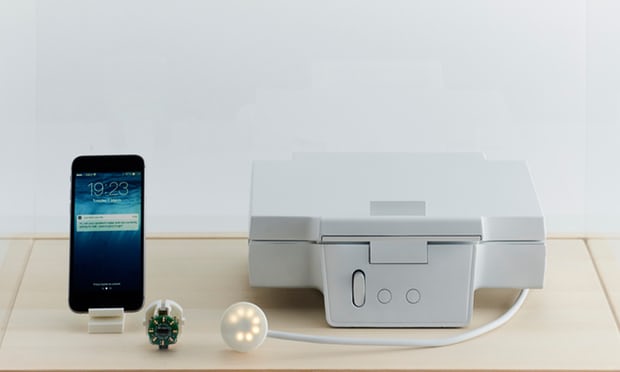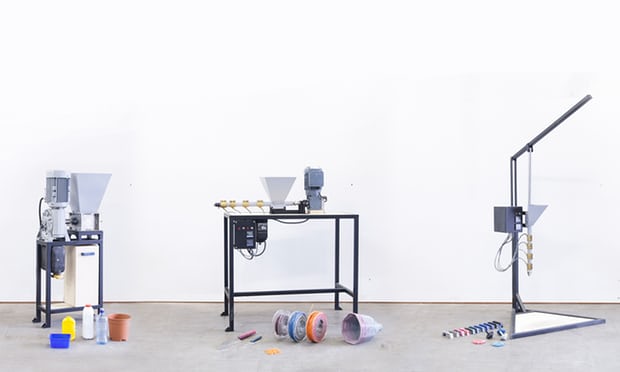Our throwaway habits are wreaking havoc on the planet. Here are six ideas from designers working to reduce waste in our everyday lives
The Nepenthes bottle is designed to do away with the need for a separate, hard-ro-recycle lid. Photograph: Marilu Valente
Modern life is wasteful. From the plastic packaging that fills our kitchens – and ends up in our oceans – to the 40m tons of e-waste we generate per year, our throwaway culture is alive and kicking. And it’s wreaking havoc on the planet.
But a host of designers, researchers and startups are on the case, coming up with new ideas to cut waste and make life more efficient. Here are six of our favourites.
1) Use Me/Lose Me
Photograph: IDEO
What if that sandwich maker gathering dust at the back of your cupboard could list itself on eBay? That’s the vision of design consultancy IDEO, which has come up with a proposal for getting unloved appliances back into circulation, saving materials and money and diverting e-waste from landfill. The Use Me/Lose Me service would monitor your appliances via web-connected chips and if anything went unused for too long, ping you a text with its likely market value. By replying to the text, you would authorise it to upload the product’s details on to an auction site and manage the sale, payment and shipping process – leaving you just to remove it from the cupboard and take it to the front door, says IDEO portfolio director Chris Grantham. The key question, he says, is: “How can we make this easier than remembering to go to the dump on a Saturday?”
2) Bottles without lids
Photograph: Marilu Valente
When designer Marilu Valente set out to reduce waste in personal care packaging, she found inspiration in the shape of the carnivorous Nepenthes plant. Her resulting bottle design aims to tackle the problem of small, hard-to-recycle bits of plastic which often end up in landfill, or waterways, by doing away with the need for a separate lid. Instead of a cap, the bottle’s flexible, slender spout plugs into a cavity on the side, sealing the container when it’s not in use. Nepenthes, which is currently just a prototype, also unplugs at the bottom, making it easy to clean and reuse, says Valente. The self-funded designer, who has not yet settled on a material for the concept, says she is in talks with mould manufacturers and has been approached by personal care brands.
3) DIY plastics recycling
Photograph: Precious Plastic
If Dutch designer Dave Hakkens gets his way, all of us could soon be turning plastic packaging into new products via home or community-based plastic recycling machines. His open-source Precious Plastic device is designed to give ordinary people around the world the tools to turn plastics lying around their neighbourhoods into useful and valuable items, from clipboards to bowls. Hakkens shares blueprints, step-by-step instructions and useful templates online to help people build and operate the machines, which he says are easy to assemble using basic tools and low-cost materials. The technology, which was highlighted in a recent report on digital disruption by UK innovation foundation Nesta, can be used to start a business, he says – and he won’t be asking for a share of the profits.
4) Tabletop composting
Photograph: Bionicraft
Taiwan-based startup Bionicraft wants to encourage urban dwellers living in small spaces to put their food scraps somewhere more useful than the bin. Its indoor, table-top ecosystem uses earthworms to turn food waste into soil, which is then used as a bed for plants, or can be removed for use in other plant pots. The system, is able to process up to 3kg of food waste per week, says founder Brooklyn Chao, who hopes it will also remind people to reduce waste by planning their meals better. Chao’s team raised around $60,000 (£46,000) on Kickstarter to fund project development and the first production batch, priced at $169 a go, will be ready to ship soon, says Chao.
5) Fruit-protecting plasma
Photograph: Lerina Winter/Winter Creative
Also taking on the food-waste challenge are startups and researchers promising to radically extend shelf life. California-based Apeel Sciences is touting an “invisible, tasteless and edible” substance made from waste farm produce such as banana peel and broccoli stalks, which it says can roughly double the life of avocados, mangos and citrus fruits by providing a protective layer against oxidation and transpiration. Meanwhile, Australian researcher Kirsty Bayliss has found a way to use plasma technology – already established in medicine and dentistry – to ward off mould from fresh produce and grains. In lab tests the technique, which uses an electrical charge to generate the plasma, doubled avocado shelf life to 10 days, says Bayliss. She is hoping to trial the approach at scale in the avocado industry and expects eventually to develop a small device for use at home, or by smallholder farmers, with a price tag of around $100.
6) Single-use shampoo pods
Photograph: Nohbo
When 14-year-old Benjamin Stern saw a video of a turtle snarled up in plastic waste, he decided to start a business focused on getting unnecessary plastics out of the bathroom. Now 18, the CEO of Nohbo is four years – and a couple of prototypes – into his project to develop packaging-free, single-use shampoo portions for travellers and hotels. First designed as a hard ball which lathered on contact with water, Nohbo had to be redesigned after some of the first commercial batch broke apart during shipping last year, says Stern. The latest version is a shampoo pod, encased in a film made from water-soluble polymer PVOH. The company aims to release the new line in Autumn this year, says Stern.
Article Source: The Guardian







